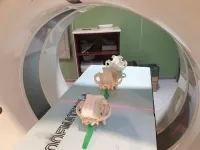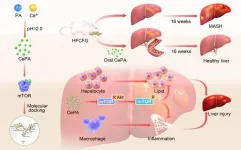(Press-News.org) Industrial emissions are one of the main sources of climate change-inducing carbon dioxide (CO2). While adopting renewable and clean energy alternatives is one option for mitigating these carbon emissions, carbon capture technology is another solution to control CO2 emissions. In big CO2-emitting industries, such as cement, oil refineries, and thermal power plants, carbon capture technology can be easily applied to remove CO2 emissions directly at the source at a feasible cost and with low energy consumption. Different materials have been explored for CO2 capture in factories, including zeolites, metal−organic frameworks, natural minerals, alkalis, and alkali metal salts. Among them, alkali metal carbonates, such as sodium carbonate (Na2CO3), are considered effective and inexpensive materials with stable properties and easy procurement.
Theoretically, Na2CO3 has a decent CO2 capture capacity and can be easily regenerated for successive uses. However, directly applying Na2CO3 to capture CO2 causes crystal agglomeration, leading to poor efficiency and shorter longevity. This issue can be eliminated by using a carbon skeleton for Na2CO3. Porous carbon materials with good pore connectivity provide low density, structural stability, hydrophobicity, and a large surface area that can stabilize Na2CO3. Previous studies report that Na2CO3−carbon nanocomposites have a CO2 capture capacity of 5.2 mmol/g. However, these studies do not inspect the effect of the carbonization temperatures on the overall performance of the material.
Therefore, in a new study published in Energy & Fuels on June 12, 2024, Professor Hirofumi Kanoh and Bo Zhang from the Graduate School of Science, Chiba University, synthesized a hybrid CO2 capture material consisting of Na2CO3 wrapped with porous nanocarbon. They further evaluated its CO2 capture and regeneration efficiencies at different carbonization temperatures. The Na2CO3−carbon hybrids (NaCH) were derived by carbonization of disodium terephthalate at temperatures ranging from 873K to 973 K in the presence of nitrogen as a protective gas. "Reducing CO2 emissions is an urgent issue, but research on the methods and material systems for CO2 capture are still lacking. This Na2CO3−carbon hybrid system proved promising in our initial investigations, prompting us to explore it further," states Prof. Kanoh.
The team measured the hybrid materials' CO2 capture capacity under humid conditions to mimic the conditions of factory waste exhaust gases. They found that the NaCH hybrids prepared at carbonization temperatures near 913–943 K demonstrated higher CO2 capture capacities. Among them, NaCH-923 had the highest CO2 capture capacity of 6.25 mmol/g and a high carbon content of over 40%, which resulted in a larger surface area, enabling a more uniform distribution of Na2CO3 on the nanocarbon surface. This reduced the rate of Na2CO3 crystal agglomeration and led to faster reaction rates.
After NaCH-923 effectively captured CO2, the scientists again heated the resultant NaCH-923-CO2 in the presence of nitrogen to test its regeneration performance. They found that NaCH-923 could be regenerated and used for CO2 capture for 10 cycles, while retaining over 95% of its initial CO2 capture capacity. These results indicate that NaCH-923 exhibits good structural strength, durability, and regeneration, which makes it an excellent material for CO2 capture under humid conditions.
Further experiments on the NaCH-923-CO2 showed that the sample underwent a steep mass change at 326−373 K (around 80 °C on average). Since the temperature of the exhaust gas from thermal power plants is also typically in that range, the waste heat from factories and power plants can easily be used as a heat source for regenerating NaCH-923, thereby effectively reducing energy consumption.
These findings show that the carbonization temperature significantly influences the CO2 capture performance and carbon content of NaCH hybrids, with NaCH-923 exhibiting the best characteristics. NaCH-923, being a solid adsorbent, can efficiently capture CO2 at ambient temperature and pressure with high selectivity for CO2 and without the problem of equipment corrosion that exists with liquid adsorbents currently used in industries. Moreover, these characteristics allow for its widespread application in various configurations, environments, and diverse industrial settings.
"By transforming Na2CO3, which already has a good CO2 capture capacity, into a nanocomposite, it became possible to improve the reaction rate and reduce the decomposition and regeneration temperature. This enables the use of factory waste heat for regeneration at around 80 °C, giving us an energy-cost efficient CO2 capture system," concludes Prof. Kanoh.
About Professor Hirofumi Kanoh
Hirofumi Kanoh is a Professor at the Graduate School of Science, Chiba University, Japan. He heads the 'Kanoh Lab' or the Molecular Chemistry Lab at the Department of Chemistry. His core research specialization is in physical chemistry with a focus on the creation and characterization of novel nanoporous solids. His research aims to develop new molecular science that can help protect the earth's environment by utilizing nanospace in solids, and to create basic science aimed at understanding and applying new functions of nanospace and nanostructured materials. He has over 300 publications and over 45 patents in the field of nanochemistry.
END
Capturing carbon with energy-efficient sodium carbonate−nanocarbon hybrid material
Scientists have developed a nanocomposite material with sodium carbonate and nanocarbon to capture carbon dioxide from industrial emissions.
2024-07-16
ELSE PRESS RELEASES FROM THIS DATE:
Digital dog and cat skull database
2024-07-16
The ELTE Eötvös Loránd University is home to the skulls of more than 150 dog breeds and other animals. To make this unique collection accessible to all, researchers digitised the skulls of 431 dogs, cats and wild relatives. The database can be used for educational and research purposes.
Tibor Csörgő, a researcher at ELTE, has been collecting animal skulls for decades to teach anatomy to biologists. The shape of the skull varies considerably between species and breeds, especially in dogs, where, for example, greyhounds have long skulls and the now popular French bulldogs have rounded skulls.
A skull biobank ...
Breaking through silicon
2024-07-16
Overcoming Historical Barriers
Silicon, the cornerstone of modern electronics, photovoltaics, and photonics, has traditionally been limited to surface-level nanofabrication due to the challenges posed by existing lithographic techniques. Available methods either fail to penetrate the wafer surface without causing alterations or are limited by the micron-scale resolution of laser lithography within Si. In the spirit of Richard Feynman's famous dictum, 'There's plenty of room at the bottom', ...
A new study finds that early detection of miRNAs in maternal blood may offer the potential for predicting preeclampsia
2024-07-16
Preeclampsia (PE) is a significant contributor to the increase in maternal morbidity and mortality worldwide, with particularly alarming numbers in the United States, where it affects about 2–8% of pregnancies, resulting in premature birth with associated morbidities for their infants as well. A new study by researchers at UCLA Health finds that early detection of specific microRNAs (miRNAs) packaged in vesicles may offer the opportunity to predict preeclampsia in pregnant people before clinical symptoms manifest.
The study, led by Dr. Sherin U. Devaskar, MD, executive chair of the Department of Pediatrics ...
Recycled micro-sized silicon anodes from photovoltaic waste improve lithium-ion battery performance
2024-07-16
Researchers from the Qingdao Institute of Bioenergy and Bioprocess Technology (QIBEBT) of the Chinese Academy of Sciences have developed low-cost micro-sized silicon anodes from recycled photovoltaic waste using a novel electrolyte design.
Their pioneering work, published in Nature Sustainability on July 16, offers a path to more sustainable, low-cost, and high-energy-density batteries that could transform energy storage systems for electric vehicles and renewable energy applications.
Silicon anodes are favored for their ability to substantially increase the energy density of lithium-ion batteries compared to traditional graphite anodes but are hindered by significant volume ...
Current international poverty line a ‘misleading shortcut method’, say experts
2024-07-16
Billions of dollars in foreign aid could be spent more effectively if international poverty statistics were more accurate, according to new research led by King's College London.
Dr Michail Moatsos, a research fellow in the Department of International Development, says current methods for calculating the international poverty line lead to a skewed picture of how poverty is distributed across the world – and this is hampering attempts to eradicate it.
“Currently, international donors cannot prioritise their funds based on the best possible information and therefore funnel those funds to those most in need around the world. A $2.15 per day poverty line affords very different ...
Food aroma study may help explain why meals taste bad in space
2024-07-16
Scientists from RMIT University have led a world-first study on common food aromas that may help explain why astronauts report that meals taste bland in space and struggle to eat their normal nutritional intake.
This research, which is published in the International Journal of Food Science and Technology, has broader implications for improving the diets of isolated people, including nursing home residents, by personalising aromas to enhance the flavour of their food.
Previous research has shown that aroma plays a big role in the flavour of food.
The team in this study tested how people perceived vanilla and almond extracts and lemon essential oil changed from normal environments on ...
Weather experts discover new effect of storm - in a teacup
2024-07-16
Britain, prepare for deep depression: storms ruin tea.
A new study reveals that Storm Ciaran cut an invisible path of mayhem across southern Britain last autumn, destroying any possibility that 20 million people could have a proper cup of tea at breakfast.
The storm's record-breaking low pressure meant the boiling point of water was below the crucial 100 degrees Celsius required for a decent cuppa, meteorologists at the University of Reading have discovered.
In a study published today [Tuesday, 16 July] in the journal Weather, the scientists reported that water in Reading was boiling at just 98°C.
During the storm on the morning of November 2, ...
Sorry, I didn’t get that: evaluating usability issues with AI-assisted smart speakers
2024-07-16
With the rapid development of AI technology, voice-controlled smart speakers are becoming increasingly popular due to their convenience and ability to control compatible home devices. Despite the rise in use, smart speakers often do not have screens and little-to-none of the visual information feedback common to manually operated devices. This aspect complicates their usability, thus providing room for research and subsequent improvement.
As such, a research team led by Dr. Toshihisa Doi, a lecturer at Osaka Metropolitan University’s Graduate School of Human Life and Ecology, recruited 39 young adults (22 males and ...
Phytic acid-based nanomedicine against mTOR for metabolic dysfunction-associated steatohepatitis therapy
2024-07-16
Metabolic dysfunction-associated steatohepatitis (MASH) is one of the most common chronic liver diseases, primarily caused by metabolic disorders and systemic inflammatory responses. Although the incidence of MASH is gradually increasing, there is a lack of effective drugs and methods for its treatment, thus limiting therapeutic options for MASH. Professor Liu Lei's team has long focused on the treatment and molecular mechanisms of liver-related diseases. Due to cerium's significant antioxidant and anti-inflammatory activities, as well as its hepatophilicity and good biosafety, it shows great potential ...
Research spotlight: The impact of tobacco smoking and smoking cessation on the life expectancy of people with HIV in South Africa
2024-07-16
Krishna Reddy, MD, MS, a physician-investigator at the Medical Practice Evaluation Center and the Tobacco Research and Treatment Center at Massachusetts General Hospital and an Associate Professor of Medicine at Harvard Medical School, is the senior author of a recently published paper in Journal of the International AIDS Society: Tobacco Smoking, Smoking Cessation and Life Expectancy Among People with HIV on Antiretroviral Therapy in South Africa: A Simulation Modelling Study.
What Question Were You Investigating in this Study?
Now that more people with HIV in South Africa are on antiretroviral therapy (medicines to treat ...
LAST 30 PRESS RELEASES:
Scientists trace microplastics in fertilizer from fields to the beach
The Lancet Obstetrics, Gynecology, & Women’s Health: Taking paracetamol during pregnancy does not increase risk of autism, ADHD or intellectual disabilities, confirms new gold-standard evidence review
Taking paracetamol during pregnancy does not increase risk of autism, ADHD or intellectual disabilities
Harm reduction vending machines in New York State expand access to overdose treatment and drug test strips, UB studies confirm
University of Phoenix releases white paper on Credit for Prior Learning as a catalyst for internal mobility and retention
Canada losing track of salmon health as climate and industrial threats mount
Molecular sieve-confined Pt-FeOx catalysts achieve highly efficient reversible hydrogen cycle of methylcyclohexane-toluene
Investment in farm productivity tools key to reducing greenhouse gas
New review highlights electrochemical pathways to recover uranium from wastewater and seawater
Hidden pollutants in shale gas development raise environmental concerns, new review finds
Discarded cigarette butts transformed into high performance energy storage materials
Researchers highlight role of alternative RNA splicing in schizophrenia
NTU Singapore scientists find new way to disarm antibiotic-resistant bacteria and restore healing in chronic wounds
Research suggests nationwide racial bias in media reporting on gun violence
Revealing the cell’s nanocourier at work
Health impacts of nursing home staffing
Public views about opioid overdose and people with opioid use disorder
Age-related changes in sperm DNA may play a role in autism risk
Ambitious model fails to explain near-death experiences, experts say
Multifaceted effects of inward foreign direct investment on new venture creation
Exploring mutations that spontaneously switch on a key brain cell receptor
Two-step genome editing enables the creation of full-length humanized mouse models
Pusan National University researchers develop light-activated tissue adhesive patch for rapid, watertight neurosurgical sealing
Study finds so-called super agers tend to have at least two key genetic advantages
Brain stimulation device cleared for ADHD in the US is overall safe but ineffective
Scientists discover natural ‘brake’ that could stop harmful inflammation
Tougher solid electrolyte advances long-sought lithium metal batteries
Experts provide policy roadmap to reduce dementia risk
New 3D imaging system could address limitations of MRI, CT and ultrasound
First-in-human drug trial lowers high blood fats
[Press-News.org] Capturing carbon with energy-efficient sodium carbonate−nanocarbon hybrid materialScientists have developed a nanocomposite material with sodium carbonate and nanocarbon to capture carbon dioxide from industrial emissions.




